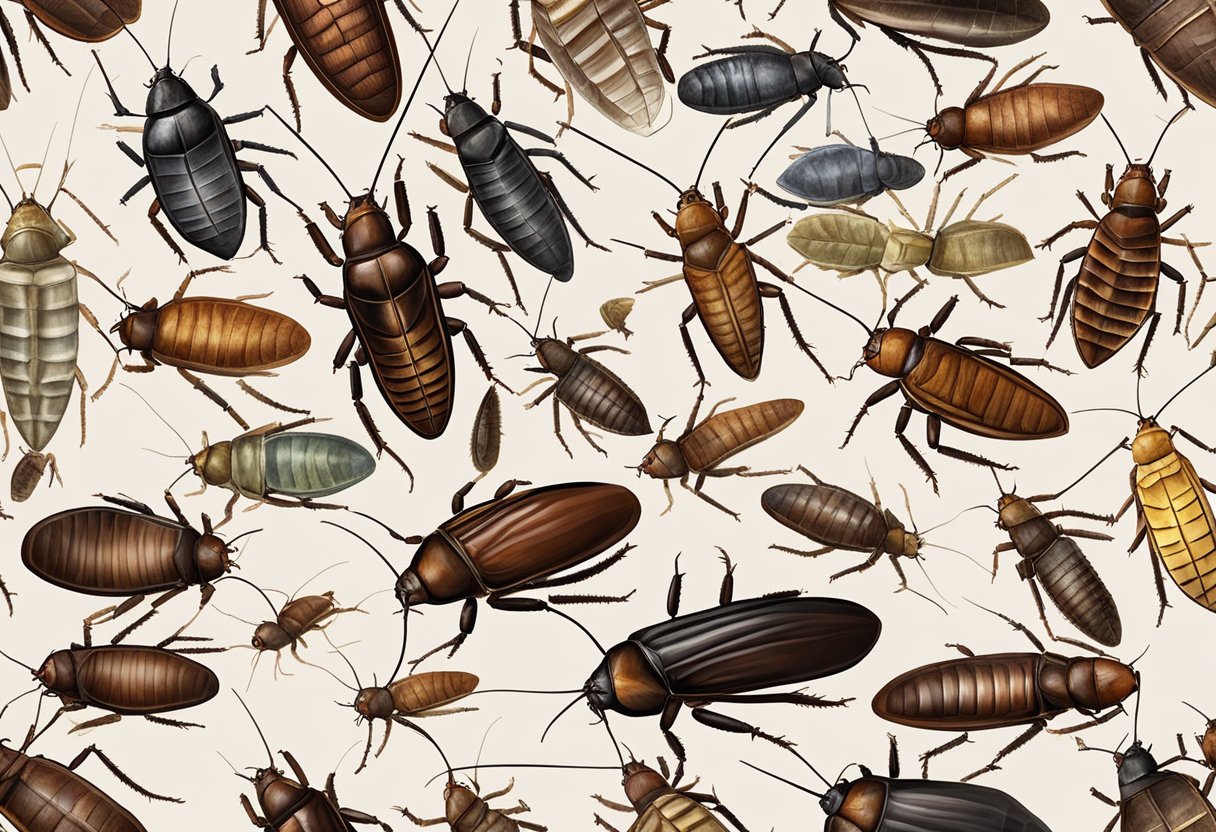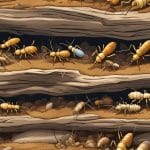Types Of Cockroaches
Cockroaches are one of the most common pests found in households and commercial spaces around the world. They are known for their resilience, adaptability, and ability to spread diseases. There are over 4,000 known species of cockroaches, but only a few of them are considered pests.
Common Cockroach Species
The most common species of cockroaches found in households and commercial spaces include American, German, Oriental, and Brown-banded cockroaches. Each species has distinct physical characteristics, habitats, and behaviors that differentiate them from one another. Identifying the species of cockroach that has infested a space can help determine the most effective method of control.
Physical Characteristics and Identification
Cockroaches are typically brown or black in color and have flat, oval-shaped bodies with long antennae. They are known for their ability to scuttle quickly and hide in tight spaces. Identifying the species of cockroach can be done by examining their physical characteristics such as size, color, and markings. Additionally, their behavior and habitat can also provide clues to their species.
Key Takeaways
- Cockroaches are common pests found in households and commercial spaces.
- The most common species of cockroaches include American, German, Oriental, and Brown-banded cockroaches.
- Identifying the species of cockroach can help determine the most effective method of control.
Common Cockroach Species

Cockroaches are one of the most common pests found in homes and buildings. There are several species of cockroaches, each with its own unique characteristics. In this section, we will discuss the most common species of cockroaches found in the United States.
American Cockroach
The American cockroach (Periplaneta americana) is one of the largest and most common species of cockroaches found in the United States. They are reddish-brown in color and can grow up to 2 inches in length. These cockroaches prefer warm and humid environments, and are often found in the southern United States. They are known to be fast runners and can fly short distances.
German Cockroach
The German cockroach (Blattella germanica) is one of the most common species of cockroaches found in homes and buildings. They are light brown in color and grow up to 1/2 inch in length. German cockroaches prefer warm and humid environments and are often found in kitchens and bathrooms. They are known to be fast breeders and can quickly infest a home if not properly controlled.
Oriental Cockroach
The Oriental cockroach (Blatta orientalis) is a common species of cockroach found in homes and buildings. They are dark brown in color and grow up to 1 inch in length. Oriental cockroaches prefer cool and damp environments, and are often found in basements and crawl spaces. They are known to be slower runners than other species of cockroaches.
Brown-Banded Cockroach
The Brown-Banded cockroach (Supella longipalpa) is a small species of cockroach that is light brown in color. They grow up to 1/2 inch in length and are often found in homes and buildings. Brown-Banded cockroaches prefer dry environments and are often found in bedrooms and living rooms. They are known to be good climbers and can infest upper floors of buildings.
Australian Cockroach
The Australian cockroach (Periplaneta australasiae) is a large species of cockroach that is reddish-brown in color. They grow up to 1 1/4 inches in length and are often found in homes and buildings. Australian cockroaches prefer warm and humid environments and are often found in the southern United States. They are known to be good fliers and can infest upper floors of buildings.
Overall, these five species of cockroaches are the most common found in homes and buildings. It is important to properly identify the species of cockroach in order to effectively control and prevent infestations.
Cockroach Habitats and Behaviors
Cockroaches are known to be adaptable creatures that can survive in various environments. Understanding their behavior and preferred habitats is crucial in controlling and preventing infestations. This section will cover the two main habitats of cockroaches: indoor and outdoor.
Indoor Infestations
Cockroaches are commonly found in kitchens, basements, and restaurants. They are attracted to areas with food and water sources, making kitchens and restaurants ideal habitats. Basements provide a dark and damp environment, which is perfect for cockroaches to thrive. Sewers and garbage are also common indoor habitats for cockroaches.
Cockroach infestations in indoor environments can cause health problems for humans. They can contaminate food and surfaces with bacteria and pathogens, leading to illnesses. Therefore, it is essential to keep indoor environments clean and free of food debris and water sources.
Outdoor Habitats
Cockroaches can also be found in outdoor environments, such as leaf piles and garbage. They prefer humid and warm environments, making leaf piles and compost bins ideal habitats. They can also be found in sewers and drains.
Preventing outdoor infestations can be challenging, but it is crucial to prevent them from entering indoor environments. Keeping outdoor areas clean and free of debris can help prevent infestations.
In conclusion, understanding the habitats and behaviors of cockroaches is essential in controlling and preventing infestations. Maintaining clean environments and eliminating food and water sources can help prevent infestations.
Physical Characteristics and Identification
Cockroaches are insects that vary in size, color, and shape. Despite their differences, they share several common physical characteristics that can help identify them.
Size and Color
Cockroaches range in size from small to large, with some species measuring only a few millimeters in length while others can grow up to three inches long. They can be light brown, dark brown, reddish-brown, or black in color. Some may also have yellow or cream-colored margins.
Wings and Mobility
Most cockroach species have wings, but not all of them can fly. Their wings can be either fully developed or reduced in size depending on whether they are fliers or not. Cockroaches are fast runners and can move quickly across surfaces.
To identify a cockroach, one can look for its six legs and three basic body parts: the head, the thorax, and the abdomen. The head features two long antennae that help the cockroach to sense its environment. Cockroaches have a flattened body with a leathery shield-like back. They also have a small head, two long antennas, six legs, two wings, and a hardened exterior.
Different species of cockroaches can be identified by their unique physical characteristics. For example, the American cockroach is reddish-brown in color and has a large size and fast mobility. The German cockroach, on the other hand, is smaller in size and light brown in color.
Overall, understanding the physical characteristics of cockroaches can help in their identification and control.
Health Risks and Prevention
Cockroaches are not only a nuisance but also pose several health risks to humans. In this section, we will discuss the various health risks associated with cockroaches and how to prevent them.
Disease Transmission
Cockroaches are known to carry and transmit various diseases, including Salmonella, E. coli, and Staphylococcus. They can pick up these bacteria while crawling through garbage, sewage, and other unsanitary areas. If they come into contact with food or surfaces in your home, they can transfer these bacteria, putting you and your family at risk of infection.
To prevent disease transmission, it is essential to keep your home clean and free of clutter. Make sure to store food in sealed containers and clean up spills and crumbs promptly. Regularly take out the garbage and keep your kitchen and bathroom areas clean.
Allergens and Asthma
Cockroaches are also a significant source of allergens, which can trigger asthma and other respiratory problems. Cockroach droppings, saliva, and shed skin contain allergens that can cause allergic reactions in sensitive individuals.
To reduce the risk of allergens, it is crucial to keep your home clean and free of clutter. Regularly vacuum carpets and rugs and wash bedding and curtains in hot water. If you or someone in your family has asthma or allergies, consider using a HEPA air purifier to remove allergens from the air.
Pest Control Methods
When it comes to controlling cockroaches, it is essential to use safe and effective pest control methods. Traditional methods such as sprays and baits can be hazardous to your health and the environment. Instead, consider using non-toxic methods such as diatomaceous earth, boric acid, or essential oils.
In addition to using safe pest control methods, it is crucial to eliminate the conditions that attract cockroaches. Keep your home clean and free of clutter, fix any leaks or moisture problems, and seal up any cracks or gaps in your walls and floors.
By following these tips, you can reduce the health risks associated with cockroaches and keep your home safe and healthy.
Ecological Impact and Adaptations
Cockroach Survival Skills
Cockroaches are known for their survival skills and are able to adapt to various environments. They have the ability to survive without food for up to a month and without water for up to a week. This is due to their ability to conserve water and their ability to feed on a wide variety of organic matter including paper, glue, and even human waste. Additionally, they are able to survive in a range of climates from the tropics to the arctic.
Cockroaches have also developed adaptations to avoid predators and survive in harsh conditions. They are able to flatten their bodies to fit into small spaces, move quickly to evade predators, and even regrow limbs if they are lost.
Role in the Ecosystem
Cockroaches play an important role in the ecosystem as scavengers. They feed on decaying organic matter, which helps to break it down and recycle nutrients back into the soil. Additionally, they are an important food source for a variety of predators including birds, mammals, and other insects.
However, while cockroaches play a beneficial role in the ecosystem, they can also be a nuisance and a health hazard when they infest human dwellings. Cockroaches can contaminate food and surfaces with disease-causing bacteria and allergens, which can lead to allergic reactions and respiratory problems in humans.
Overall, cockroaches have developed impressive survival skills and play an important role in the ecosystem as scavengers. However, their presence in human dwellings can pose a health hazard and should be addressed through proper pest control measures.






